First up, it looks like I’m going to be traveling to San Diego for the week of July 21st – does anyone know of a museum in the area with a good small arms collection to check out? Or alternatively, do you have a cool collection that you would like to share with the Forgotten Weapons readership? Drop me a line, and let me know!
Secondly, we got a handful of photos from reader Eddie, who is trying to identify a submachine gun. I don’t recognize the gun, perhaps someone reading will know more about it? The closest thing I can come up with is a Czech ZK-383, but it isn’t one of those (click to enlarge each photo for a better view).

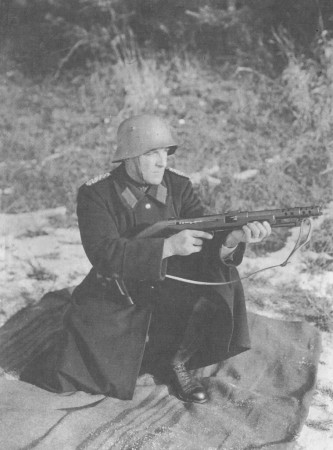
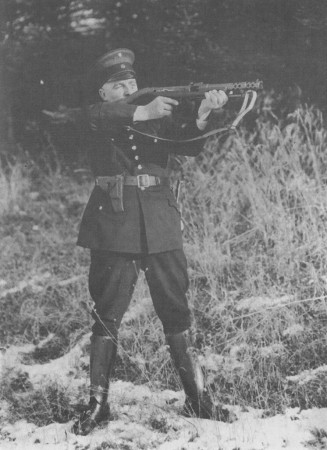
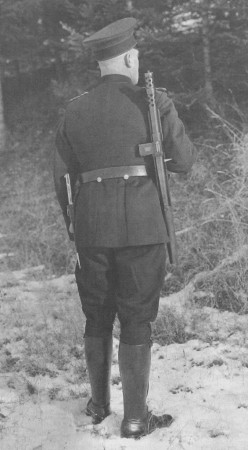
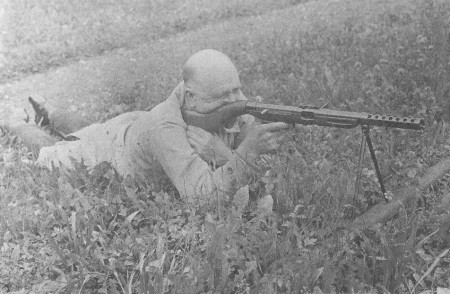
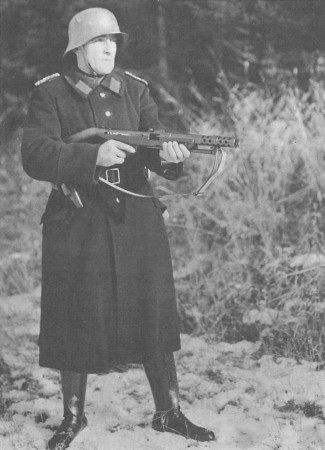
its a mauser experimental smg that lost out to the mp36
It looks to be an experimental Mauser MP
That’s a Mauser M.P.33
MCRD San Diego (Marine Corps Recruit Depot) is always a good start. They have a nice little collection, at their museum.
How are you getting to SD? Are you driving the 10?
The closest think I can think of is the
General Patton Memorial Museum
62-510 Chiriaco Road, Chiriaco Summit, CA 92201
Ian, will you have the time to look around outside of San Diego proper as well? If so, you can pull up a comprehensive list of available military museums by going to http://www.military.com, then keying in “Military Museums” in the Search Box in the upper right-hand corner of the Home Page. An entire list of such museums sorted by states should come up, and you can then search under “California” and narrow down your preferences.
That folding bipod under the barrel jacket is interesting. I guess the design stemmed from an era when pistol-caliber SMG’s were often rated as being effective out to 300 meters, so a bipod may have been thought to be handy when providing support fire.
The bipod is clamped in a position closer to the receiver in the lower left photograph ( of the boffin aiming the gun in the prone position ) as compared to the other photographs. The downswept buttstock, which appears to have been designed to compensate for the weapon’s low profile and bring the sights back into proper alignment with the firer’s line of sight, is equally interesting. It certainly has very graceful lines and shows a high standard of wood-carving craftsmanship.
Hi, the SMG was made by Mauser, and the photos are dated 17th January 1933.
The person lying on the ground is Schießmeister Wedler.
The person in uniform is Wachtmeister Scheffold.
Unfortunately I do not have any other information. The photos are owned by the Mauser museum … but without any additional information or documents.
I love those titles (schiessmeister, wachtmeister); they sound very regimented and authentic. I would expect only person of Euro or British origin to have this scope of peripheral knowledge. I am amazed.
Hello,
first of all, judging by the helmet,
the shooters are Austrians.
The but is very intersting in sape,
looks like the france made GEVARM series D,
or better the prototypes of the Swiss Furrer MP 41/44.
I like the way the shooter’s cheek
embraces the butt.
How about USS Midway, the aircraft carrier? Not our line of interest, but interesting anyway.
Good idea. The U.S.S. Midway is one of the itineraries on the list of California military museums on the http://www.military.com list, and is definitely one of the better-known representations of modern naval history with a real combat record to boot.
I second the Midway Museum. That ship is a real mutant – a WWII straight-deck carrier that’s been revamped and overhauled so many times it almost looks like a Kitty Hawk from a distance. If you love the details of military machinery it’s a total must. They’ve also got a great collection of period aircraft on the deck too, including a very impressive A-5 Vigilante (it’s enormous).
I think it is Swiss. I remember seeing a smg in a museum with that drooping stock and a bipod. Remember they developed weapons for Germany in the 20s and 30s. The role of the smg was not defined at this time;so bipods were added .
Wachtmeister (German for master-sentinel; watch-master) was a German, Austrian and Swiss military rank of non-commissioned officers.
Wachtmeister was also a German police rank. The rank of Wachtmeister was used in Germany and Austria, up to and including the Second World War, where it was a cavalry and artillery rank equating to a Sergeant-major (a Feldwebel in the infantry). The rank is used in Austria and Switzerland in the present day. In the German navy, the term is the equivalent to a Kompaniefeldwebel or Hauptfeldwebel as the senior NCO aboard a ship, usually tasked with administration.
@ Michael, Dimitris & Andrew Marcell :
The corner of the veil of mystery is being lifted a little more with each contribution. Collectively, we should be able to resolve this — thanks!
To All :
Not exactly a related subject, but for those who have a deep interest in firearm ballistics, Mike Haas’ ammoguide.com web site is offering a free on-line ballistic calculator for a wide range of complex applications from June 15-20, 2013. You can sign up as a basic member to access this article and other privileges at no cost, or you can become a paying subscriber, which will give you unlimited and complete access to everything the site has to offer. It is definitely worthwhile for anyone who is into reloading and / or has an abiding interest in the science of ballistics for all kinds of ammunition.
Hahahaaa, this thing is real treat of ergonomy. Cannot add raised sights? Ok, bend the butt then! One way or the other, it will be done.
Maybe it is just a fluke, but why is the magazine not visible in any of the photos? Were the bugs not worked out of the magazines before the photo shoot?
It is a Mauser after all. Take a look at the photo of the guy in peaked cap carrying the SMG slung from his shoulder – there is an outline of the Mauser-Tonne (the barrel-like Mauser Banner) on top of the magazine well. These copies are barely readable, but this weapon was described (well, hinted at, because no actual gun was available) in the now sadly defunct German weapon quarterly Waffen-Revue – Nr 87, (4/1992).
Karl Pawlas did wrote there, that the photos come from the Privatarchiv Schmidt, a collection that keeps most of what remained of the Mauser company archives. The copies printed there are of much higher quality and you can actually read the MAUSER inside the logo. Also, the guys pictured there are identified as “Schiessmeister Wedel”, an elderly shooting range foreman (the one prone in civilian clothes) and Wachtmeister Scheffold of the Oberndorf municipal police, himself a frequent visitor to the factory shooting range who posed in his uniform. The photos were found in a folder dated “1933” and some of these (those of uniformed Scheffold in the snow) bear date “Jan 17, 1933” – two weeks before Hitler’s electoral take-over.
The mysteriously relocating bipod seems to be placed onto a sleeve, sliding along the “shoulder thing that goes up” (=bbl shroud) and clamped into position by the large slotted screw, tensioning the sleeve (or probably the slotted head is the release buton of a spring-loaded catch?). A very similar bipod attachment (but tensioned with a vise-handle on a screw) could be found on the 1924 prototype Suomi with sliding bipod.
The only material trace of the Mauser SMG known today is the barrel preserved at the Schwedenbau museum in Oberndorf – which is curiously chambered for 9 x 23 Steyr ammunition. The gun itself was probably ‘liberated’ by the French, occupying the area in 1945. Before blowing up Mauser plant in 1947, after two years of intense manufacturing of K98ks, P38s, and even P08s for their military, they have evacuated everything not built into the walls, and then blew up empty skeletons of the the factory.
Ever since then early and rare Mauseralia keep popping up somewhere in France – so maybe sometime some French family would turn the Mauser MP in after the veteran dies.
And it’s Leszek again to the rescue! I have to say, I am completely surprised by the 9×23 Steyr chambering from Mauser – it’s not like any former members of Austria-Hungary were in the market for a submachine gun, and it’s also not like the Reichswehr was willing to secretly order submachine guns in a caliber that would raise eyebrows towards itself. Maybe it was easier to purchase stocks for civilians of 9×23? Although, then again, that doesn’t make sense. I really can’t figure out why that, unless Austria was secretly contracting Mauser. That in and of itself would be interesting to figure out the story behind, although by this point it might be impossible to learn.
A decade too late to the party but there’s actually a complete Mauser MP 33 at the Canadian War Museum. I have photos of it on my website.
As for the 9x23mm chambering, this was probably done for the Austrian market. In fact, the gun has a quick-change barrel which can be swapped out for different cartridge chamberings. It is more likely that the gun pictured here is chambered in 9x19mm.
Agreed — This is an excellent and knowledgeable insight that Leszek has provided.
I think this was the German attempt to try to copy the ZK-383 or to try to replace it even thoe they have occupied the Brno factory and used the ZK-383 from then.